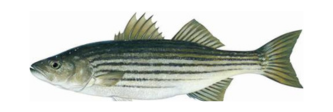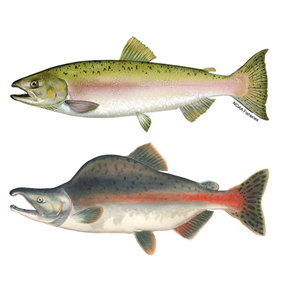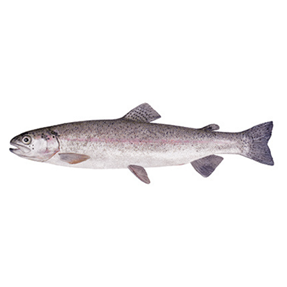The basics
River species
Fish species found in Quebec’s salmon rivers
KEY DIFFERENCES
As seen in the Fishing according to the rules section, sport fishing for Atlantic salmon is regulated by several laws specific to the species. It is therefore essential to be able to identify an Atlantic salmon as well as the other species that inhabit salmon rivers in order to properly follow regulations.
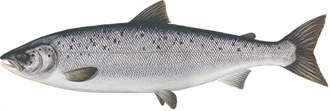
ATLANTIC SALMON
Atlantic salmon are a cold-water species that need different habitats at different stages of their life cycle. Born in freshwater, they migrate out into the ocean to feed and grow and return to freshwater to breed or spawn. Salmon can travel up to 2,500 km across the Labrador Sea to Greenland. Atlantic salmon have an incredible sense of direction that guides them back to freshwater, specifically to the river where they were born.
In freshwater, Atlantic salmon need clear, cool, fast-moving water and a gravel bottom in order to spawn, and there must be rocky areas for the juvenile fish. Salmon are often found in pools that offer protection from predators and warmer temperatures, and where currents allow them to rest.
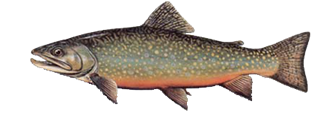
BROOK TROUT
Brook trout can be anadromous (sea trout) or resident (brook trout).
While resident brook trout complete their entire life cycle in freshwater, the anadromous ecotype (sea trout) migrates varying distances to maximize their growth in estuarine or coastal areas before returning to spawn in their native river.
STRIPED BASS
Striped bass are a typical fish found in estuaries and coastal areas of eastern North America. It is an anadromous fish: spawning, incubation and initial development of the fry take place in fresh water. The juvenile bass then move to brackish and then out to salt water, where they feed and grow for a few years before reaching maturity.
Rivers are not the preferred habitat of striped bass, but some are found in rivers for variable periods of time. A form for reporting striped bass sightings on salmon rivers is available here and the information is used in follow-up studies with the MELCCFP.
Striped bass have an elongated, laterally compressed body, a triangular head and a large mouth with a protruding lower jaw. It has two separate dorsal fins, the first of which is spiny. Its back is dark olive green or black, its sides, pale or silver, and its belly, white. It has seven or eight dark horizontal stripes on its flanks, corresponding to the contour of its scales.

LANDLOCKED SALMON
Landlocked salmon are freshwater salmon native to Lac-Saint-Jean and the North Shore. They are a smaller variety of salmon than the Atlantic salmon and are not anadromous. They are rarely found in officially designated salmon rivers but can occasionally be observed.
Landlocked salmon feed on fish, mainly rainbow smelt. The juveniles feed mainly on insects. In the river during spawning until their return to the lake, the adults stop feeding, except for a few insects eaten on the surface.
INVASIVE SPECIES
The following species are invasive species that should not be found in Quebec salmon rivers.
If you catch any of these species in a salmon river, you are encouraged to keep them for consumption and report them to the river manager.
For more information and to report an invasive species, go to the Make a Report page.
PINK SALMON
Pink salmon are a West Coast breed of salmon. Their presence in our streams can have an impact on native species.
In their bright silver phase (shown at the top of the image above), they can be distinguished by the large black spots on their back, the absence of black spots on the operculum (side of the head) and the elongated dark spots on their tail.
In their reproductive phase (shown at the bottom of the image above), they can be distinguished by the hump on their back (males) and a pink or red line along their body.
RAINBOW TROUT
Rainbow trout frequent our lakes and streams and can impact native aquatic wildlife.
You can tell them apart by their black spots on their dorsal fin, their silver side and their wide horizontal pink stripe that can tend to turn pink or red.

